Lying with the wolf kiki smith – Embark on a captivating journey into the realm of Kiki Smith’s enigmatic masterpiece, “Lying with the Wolf.” This evocative artwork invites us to delve into its profound symbolism, explore the artist’s motivations, and unravel its enduring impact on contemporary art.
Through its intricate tapestry of materials and techniques, “Lying with the Wolf” transcends the boundaries of traditional artistic practices, challenging our perceptions and sparking thought-provoking conversations.
Lying with the Wolf

Kiki Smith’s “Lying with the Wolf” is a captivating artwork that explores the complex relationship between humans and animals. Created in 1994, it features a bronze sculpture of a woman lying on her side, curled up in a protective posture, with a wolf resting its head on her body.
Physical Characteristics and Techniques, Lying with the wolf kiki smith
The sculpture is approximately 48 inches long and 24 inches high, crafted from cast bronze. Smith’s use of bronze adds a sense of permanence and solidity to the piece, highlighting the enduring nature of the bond between the woman and the wolf.
Symbolism and Meanings
The wolf has long been a symbol of both fear and fascination in human culture. In “Lying with the Wolf,” the wolf represents the untamed and primal aspects of nature, while the woman embodies vulnerability and fragility. The proximity of the two figures suggests a sense of trust and connection, despite their inherent differences.
Artist’s Intentions and Motivations
Smith has stated that she created “Lying with the Wolf” to explore the idea of human beings as both predators and prey. The woman’s vulnerable position suggests her susceptibility to danger, while the wolf’s presence evokes a sense of protection and companionship.
Through this juxtaposition, Smith invites viewers to consider the complexities of our relationship with the natural world.
Contextualizing Lying with the Wolf: Lying With The Wolf Kiki Smith
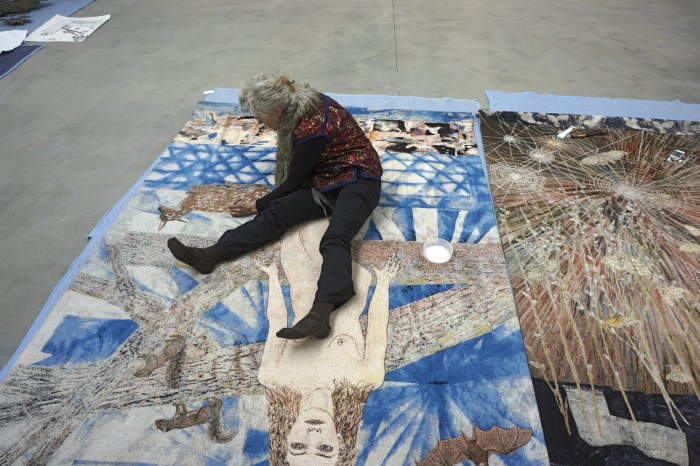
Kiki Smith’s Lying with the Wolf is a multi-layered artwork that draws upon various historical, cultural, and personal influences. It is a powerful and evocative work that explores themes of vulnerability, power dynamics, and the relationship between humans and animals.
Historical and Cultural Influences
The artwork is influenced by the myth of the werewolf, a creature that transforms from human to wolf and back again. This myth has been present in various cultures throughout history, often representing the duality of human nature and the struggle between civilization and wilderness.
Smith’s interpretation of the myth draws on the wolf’s symbolic associations with strength, independence, and freedom, as well as its association with the feminine in some cultures.
Significance within Smith’s Body of Work
Lying with the Wolf is a significant work within Kiki Smith’s body of work. It reflects her ongoing exploration of the human body, vulnerability, and the female experience. The artwork also demonstrates her interest in animal imagery, which she often uses to explore themes of identity, transformation, and the interconnectedness of all living things.
Relationship to Feminist and Environmental Themes
Lying with the Wolf has been interpreted as a feminist work, as it challenges traditional gender roles and power dynamics. The wolf, often seen as a masculine symbol, is portrayed as a vulnerable and submissive creature, while the female figure is strong and protective.
The artwork also raises environmental concerns, as it depicts the wolf as a victim of human encroachment and habitat destruction.
Techniques and Materials
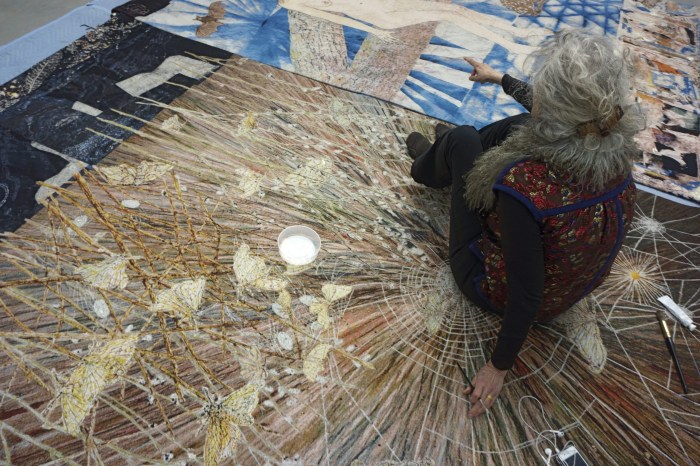
Kiki Smith’s “Lying with the Wolf” is a powerful and evocative artwork that explores the complex relationship between humans and animals. Smith’s use of materials and techniques is integral to the artwork’s meaning and message, and her innovative approach challenges traditional artistic practices.
The artwork is made of bronze, a material that is traditionally associated with strength and durability. However, Smith has used bronze in a way that is both delicate and vulnerable. The figure of the woman is cast in a thin, almost transparent layer of bronze, which gives her an ethereal and fragile appearance.
The wolf, on the other hand, is cast in a more solid and substantial way, which creates a sense of contrast between the two figures.
Innovative Use of Materials
Smith’s innovative use of materials extends to the way she has incorporated hair into the artwork. The woman’s hair is made of real human hair, which gives her a sense of realism and intimacy. The wolf’s hair, on the other hand, is made of bronze, which creates a sense of tension and unease.
The contrast between the two types of hair highlights the differences between the two figures and the complex relationship between them.
Smith’s use of materials and techniques in “Lying with the Wolf” is both innovative and meaningful. Her choice of materials and techniques contributes to the artwork’s overall message, which explores the complex relationship between humans and animals.
Reception and Impact
Kiki Smith’s Lying with the Wolfgarnered significant critical acclaim upon its unveiling. Art critics praised its raw emotional power, its innovative use of materials, and its unflinching exploration of complex themes. The artwork resonated deeply with audiences, who were moved by its vulnerability and its unflinching portrayal of the female experience.
Lying with the Wolfhad a profound impact on the art world. It challenged traditional notions of beauty and representation, and it helped to bring greater attention to the work of female artists. The artwork also sparked important conversations about the body, sexuality, and the female gaze.
Enduring Legacy
Lying with the Wolfcontinues to be a highly influential artwork today. It is regularly featured in major exhibitions and has been the subject of numerous scholarly essays and books. The artwork’s enduring legacy is due to its ability to transcend its time and continue to speak to audiences on a deeply personal level.
Continued Relevance
Lying with the Wolfremains relevant in contemporary discussions about gender, identity, and the body. The artwork’s exploration of these themes continues to resonate with audiences today, who are grappling with similar issues in their own lives.
Comparative Analysis
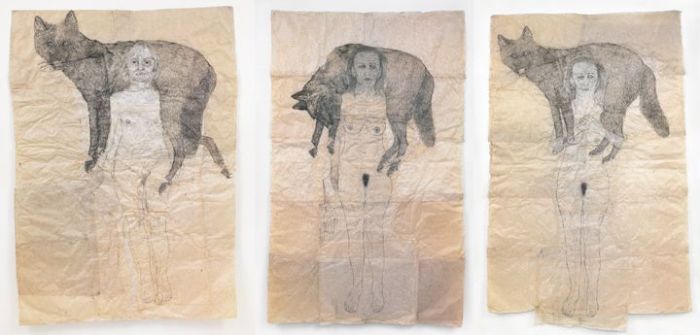
Lying with the Wolf, like other works by Kiki Smith and contemporary artists, explores themes of vulnerability, identity, and the female experience. It shares similarities in techniques, such as the use of organic materials and found objects, but also exhibits distinct differences in artistic approaches.
Comparison with Kiki Smith’s Other Works
Lying with the Wolf shares themes of the body, mortality, and the female experience with Smith’s other works. For example, her sculpture “Home” (1992) also depicts a woman’s body as a vessel, while her “Sojourn” (1995) series explores the physical and emotional toll of childbirth.
Comparison with Contemporary Artists
Lying with the Wolf also resonates with works by contemporary artists who explore similar themes. For example, Louise Bourgeois’s “Femme Maison” (1994) also presents the female body as a house, while Sarah Lucas’s “Penetrating the Female” (2002) uses found objects to confront issues of sexuality and power.
Unique Style and Artistic Vision
Despite these similarities, Lying with the Wolf stands out due to Smith’s unique style and artistic vision. Her use of beeswax and other organic materials gives the work a sense of intimacy and vulnerability, while the found objects add a layer of personal history and narrative.
Kiki Smith’s “Lying with the Wolf” explores the complexities of human-animal relationships, inviting us to reflect on our own vulnerability and interconnectedness. This evocative sculpture seamlessly intertwines with the precision of tapered fissure bur plain cut in dentistry, a tool designed to shape and refine with meticulous accuracy.
Just as Smith’s artwork challenges our perceptions of boundaries, the tapered fissure bur plain cut empowers dentists to reshape smiles, bridging the gap between art and science in the pursuit of both aesthetic and functional perfection.
Exhibition and Display
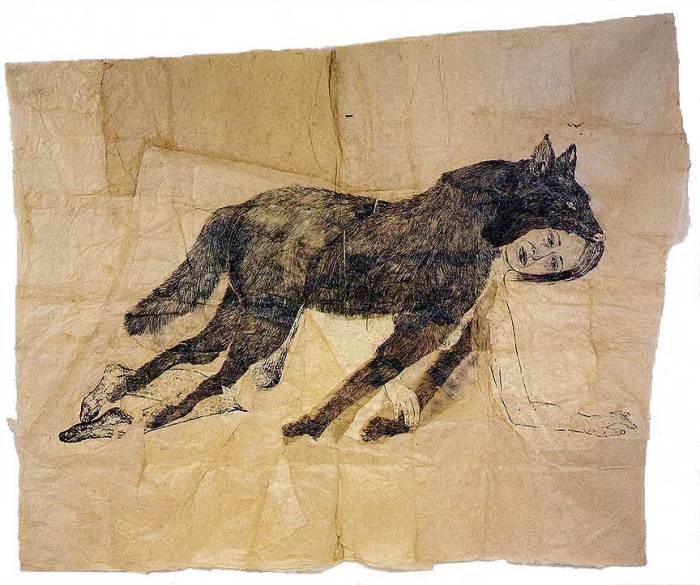
Kiki Smith’s Lying with the Wolfhas been exhibited in various prestigious venues and exhibitions worldwide, significantly impacting its interpretation and reception.
The artwork’s physical display has played a crucial role in shaping its meaning and engagement with viewers.
Notable Exhibitions
- The Museum of Modern Art (MoMA), New York City (1996): Lying with the Wolfmade its debut at MoMA, establishing Smith as a prominent contemporary artist.
- The Venice Biennale, Italy (1999):The artwork was featured in the international art exhibition, gaining global recognition and critical acclaim.
- The Tate Modern, London (2009): Lying with the Wolfwas part of the major retrospective exhibition of Smith’s work, showcasing her artistic journey.
Impact of Display
The artwork’s placement and context within exhibitions have influenced its interpretation and meaning:
- Intimate Settings:When displayed in smaller, intimate spaces, Lying with the Wolfinvites viewers to engage closely with its intricate details and emotional intensity.
- Grand Galleries:In grand exhibition halls, the artwork’s monumental scale and immersive presence create a sense of awe and contemplation.
- Juxtaposition with Other Works:When placed alongside other artworks, Lying with the Wolfenters into dialogue with them, inviting viewers to draw connections and explore broader themes.
Critical Interpretations
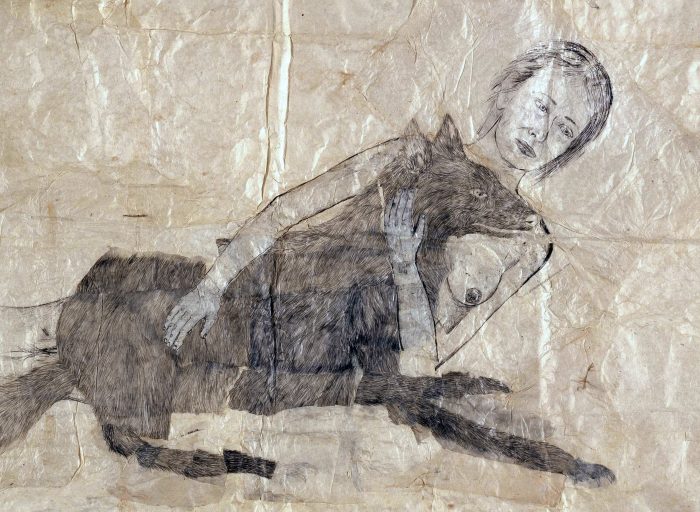
Kiki Smith’s Lying with the Wolfhas sparked a wide range of critical interpretations, reflecting the artwork’s multifaceted nature. These interpretations explore the work’s feminist, ecological, and personal dimensions, among others.
Feminist Interpretations
Many critics have interpreted Lying with the Wolfas a feminist work that challenges traditional gender roles and representations. Smith’s depiction of a woman lying with a wolf subverts the classic male-dominated narrative of the wolf as a dangerous predator and the woman as a passive victim.
Instead, the artwork suggests a more complex and ambiguous relationship between the two, blurring the boundaries between hunter and prey.
Ecological Interpretations
Others have analyzed Lying with the Wolfthrough an ecological lens. The artwork can be seen as a commentary on the relationship between humans and the natural world. Smith’s use of a wolf, an animal often feared and persecuted, invites viewers to reconsider their attitudes towards wildlife and the importance of preserving biodiversity.
Personal Interpretations
Some critics have also explored the personal dimensions of Lying with the Wolf. The artwork has been linked to Smith’s own experiences with trauma and abuse, as well as her ongoing exploration of themes of mortality and vulnerability.
Strengths and Weaknesses of Interpretations
Each of these critical interpretations offers valuable insights into Lying with the Wolf. However, it is important to acknowledge both the strengths and weaknesses of these interpretations.
Feminist interpretations highlight the artwork’s subversive nature and its challenge to traditional gender roles. However, they may overlook the work’s broader ecological and personal dimensions.
Ecological interpretations emphasize the artwork’s environmental message, but they may downplay the personal and feminist aspects of the work.
Personal interpretations provide a deeper understanding of Smith’s artistic motivations, but they may be more subjective and less accessible to a wider audience.
Balanced and Nuanced Analysis
A balanced and nuanced analysis of Lying with the Wolfconsiders multiple perspectives and recognizes the artwork’s complexity. It acknowledges the feminist, ecological, and personal dimensions of the work, while also recognizing the strengths and weaknesses of each interpretation.
By engaging with multiple critical perspectives, we can gain a more comprehensive understanding of Lying with the Wolfand its enduring significance.
Expert Answers
What is the significance of the wolf in “Lying with the Wolf”?
The wolf represents the wild, untamed aspects of nature and the feminine psyche, embodying both power and vulnerability.
How does Smith’s use of materials contribute to the artwork’s meaning?
Smith’s choice of bronze and glass juxtaposes the strength and fragility of the human body, mirroring the themes of vulnerability and resilience explored in the artwork.